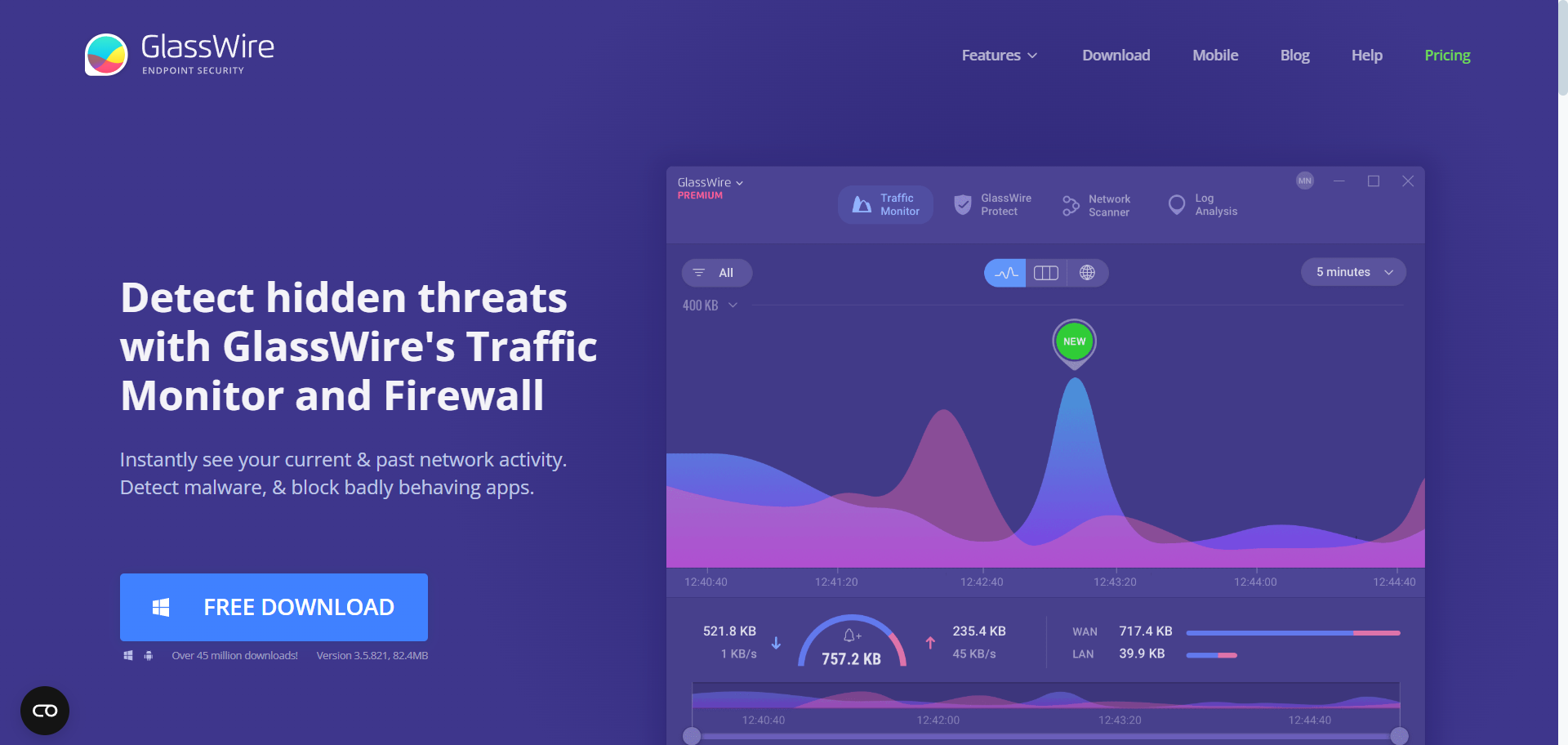Why you can trust TechRadar
We spend hours testing every product or service we review, so you can be sure you’re buying the best. Find out more about how we test.
Technology is moving at an increasingly fast pace, requiring more and more data and bandwidth as it does. This means that keeping track of everything that is going on can be challenging, especially if you’re looking to track how much data you’re using and what external threats could have access to your network. Luckily for Windows users, Microsoft has been doing a good job, including its Windows Firewall in its operating system. Windows Firewall is by no means perfect, but it’s more than enough for the average user. However, if you belong to another group of users or are looking to “advance,” then additional firewall tools may be required to give you the granular control and overview of your network.
Enter GlassWire, an application that, among other things, offers better manageability for the Windows Firewall. Some users may argue that a VPN could be an equally suitable solution; however, a VPN mostly protects your privacy and anonymity when you’re online, whereas a firewall takes things a step further. Namely, with a firewall, you can determine which programs should be allowed to access your network and devices. GlassWire does this remarkably well, nevertheless, users who do not have a lot of networking experience may be confused by all of the graphs and data offered by GlassWire.
Downloading and installing the app is as easy as it can be, and as soon as you launch it, the graphing starts. Your network traffic is analyzed and recorded, showing you the last five minutes of activity (for new users). Once you’ve been using the app for some time (day, week), you will get more data and “markers” on your graphs. These markers represent an individual event (i.e., first connection of an app), and they’re clickable so you can glean more information from the events. Graph spikes are also clickable, and unusual activity is also recorded. While all of this is great, if you’re an average user, it can, and does, feel simply overwhelming.
Features
While internet usage tracking represents the bread and butter of GlassWire, it can do much more. It offers an extra layer of security thanks to its in-depth analysis of each application on your computer, as well as which apps are accessing the internet and how they’re doing this. For each new event, you will get a discrete notification that contains enough information for you to make an educated step towards resolving an issue. Under the GlassWire Protect tab, you can see all of the apps on your PC as well as details such as Version, GW Score, Traffic in/out, Hosts, and download and upload speeds. Here you will also find the Firewall toggle button that lets you turn on or off the firewall functionality, which comes from Windows Firewall. GlassWire interacts with Windows Firewall for program control and reporting, which is a different approach compared to competing solutions such as ZoneAlarm, etc.
If you want to put an app onto a block list, simply click on the flame icon, or if you want, you can block all network traffic for the app if you do not wish to block the app itself. This way, you can quickly block all connections until you end the mode. If you like granular control over your network access, you can turn on the “ask to connect” mode, where you will be asked to confirm each time a program attempts to access the network. Note, if you have some apps that have already connected to the internet, this mode will not affect them. If some apps you’re using trigger a “this might be malware” alarm, GlassWire gives you the option of submitting the file to VirusTotal. VirusTotal checks the file against dozens of antivirus engines and reports how many of them recognize the file as malware. This is a handy feature, however, you will need to provide your VirusTotal API key to GlassWire (you can find the specific location to enter your API key under the settings menu). Another note, VirusTotal can present you with some false positives, so we would not rely solely on the analysis provided by them.
A short digression, the fact that VirusTotal is used, we would appreciate it if the apps would automatically show a malware score based on what VirusTotal has in its database, but that is not the case; you need to submit files to get some feedback.
If you want to configure what GlassWire monitors, you can do so in the settings under the security tab. You have 15 settings that you can tweak; in the free plan, only four are “unlocked”. By default, most of the settings are on, and GlassWire will notify you when a new device joins the network, or when a program connects for the first time, or even when a remote session starts. Speaking of remote sessions, GlassWire allows you to have a remote connection, even on the free plan (only one, though). If you move onto the paid plan, you will get an unlimited number of remote connections, but also access to something called the Wi-Fi evil twin detection. Hackers use deceitful wireless connections to gain access to devices through Wi-Fi, which means that these malicious actors can use any internet-connected PC/smartphone to create an evil twin Wi-Fi that looks legitimate. The goal is for you to connect using this evil twin and to siphon all of your data. GlassWire protects you by notifying you of any Wi-Fi password loss, the same name Wi-Fi’s or any new hardware.
If you’re a Mac user or an iOS user, you’re out of luck with GlassWire as it is not available for Apple’s ecosystem. On the positive side, you can get it on Android, using Google’s Play Store. On Android, the app looks and feels the same as the one on Windows and has all of the powerful features available on its desktop counterpart. It’s similarly easy to set up, but just like the desktop version, if you want to make additional tweaks, you will have to go for the paid version.
Pricing
You can get GlassWire completely free, with a lot of powerful features, and for most, this should be enough. However, if you’re looking for additional features, you can opt for a paid plan that starts at $2.99 for one license. While the free plan covers basic monitoring like real-time traffic, anomaly detection, and new device alerts, Premium significantly expands the toolset. It unlocks unlimited bandwidth history, full access to historical alerts, and advanced threat detection features like ARP spoofing detection, system file monitoring, and proxy settings alerts. Users can also customize and automate firewall behavior with features like unlimited app blocking, lockdown mode, and firewall profiles. For privacy-focused users, Premium offers DNS server monitoring and unlimited remote device connections. It also includes exportable usage data, an interactive network map, and dedicated customer support. Finally, the icing on the cake is the fact that the premium version also unlocks theme selection, offering roughly 13 additional themes. While the price is not that steep, the usability of the premium features comes down to the professionals who require all of the additional bells and whistles.
Protection
It’s worth noting that GlassWire is not an antivirus replacement, but a companion tool that adds a crucial layer of network-level visibility and early threat detection. The usability and blocking rate depend on your settings and how you utilize the app. There have not been any independent laboratory tests of the application, but since it uses the Windows Firewall API, its performance and effectiveness could be generally assessed within the context of the overall Windows security infrastructure, rather than through isolated testing. We tend to recommend Windows Firewall as the go-to firewall solution for most users, believing that it’s more than enough to protect you online, so take that for what it’s worth.
Ease of use
GlassWire is generally pleasing to the eye, and we enjoyed using it. The icons and settings are well laid out and logical; however, if you’re newer to the world of networking and security, all of the colors, graphs, and information can be overwhelming. An additional positive remark we would like to make here is the notifications. Most firewalls tend to bombard you with notifications, alerts, bells, and various sounds; not GlassWire, they’ve managed to implement a discreet system of notifications which we enjoyed very much. If you’re one of those people who simply have to have a notification presented to them at each activity, GlassWire somewhat allows this if you go for the ask to connect mode.
Final verdict
As far as third-party firewall apps go, GlassWire offers a unique approach and a unique experience by relying on the Windows Firewall API. It’s easy to install and get working out of the box, but interpreting all of the data requires some “advanced” computer knowledge that is not common among PC users. If you’re an average user who has never even fired up Windows Firewall settings, then keep enjoying your browsing experience and skip over any additional firewall tools. GlassWire is not for you!
On the other hand, if you’re a competitive gamer looking to squeeze the last iota of performance from your network, analyzing your networking with a tool like GlassWire makes a lot of sense. We also see security professionals benefiting from such a tool, especially under the paid plan, since it offers a granular approach to tweaking your network and devices on it. We’re sure others can benefit from the app, but paying for more licenses certainly has to have a business value behind it.
All in all, GlassWire is a great addition to Windows Firewall. The fact that you have a free forever version gives you a great opportunity to test it out or even use it fully without the need to make a purchase. The developers behind the app are active across various developer forums, giving us confidence that user feedback is appreciated and updates are going to keep coming.
Read the full article here














